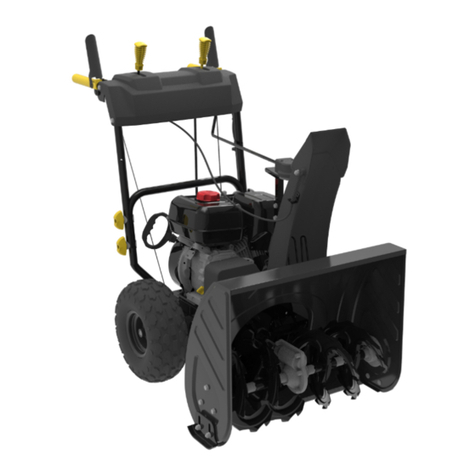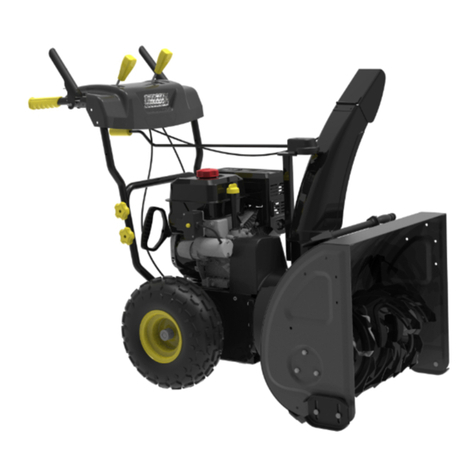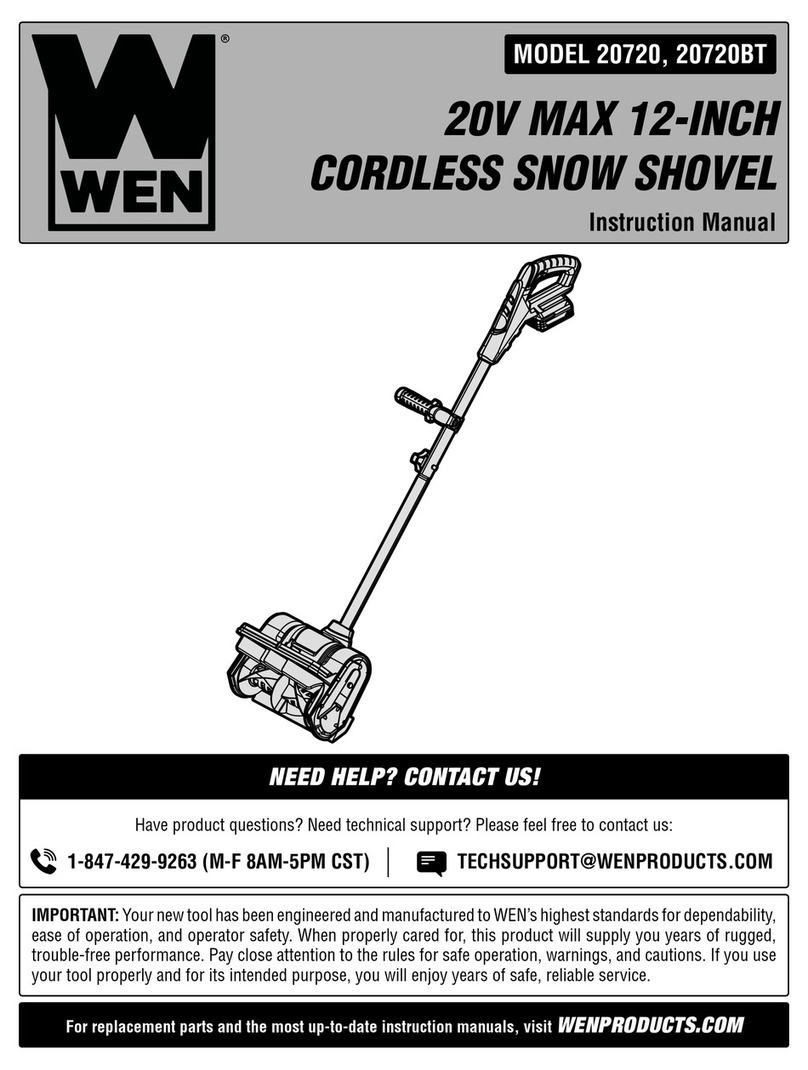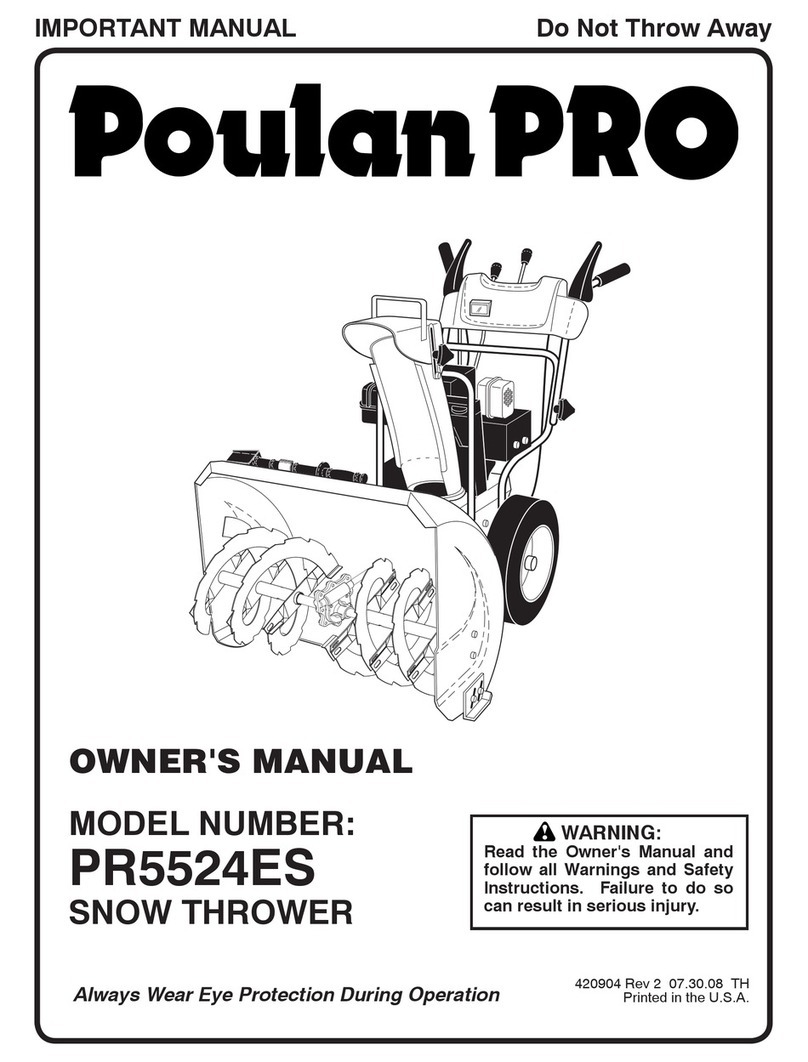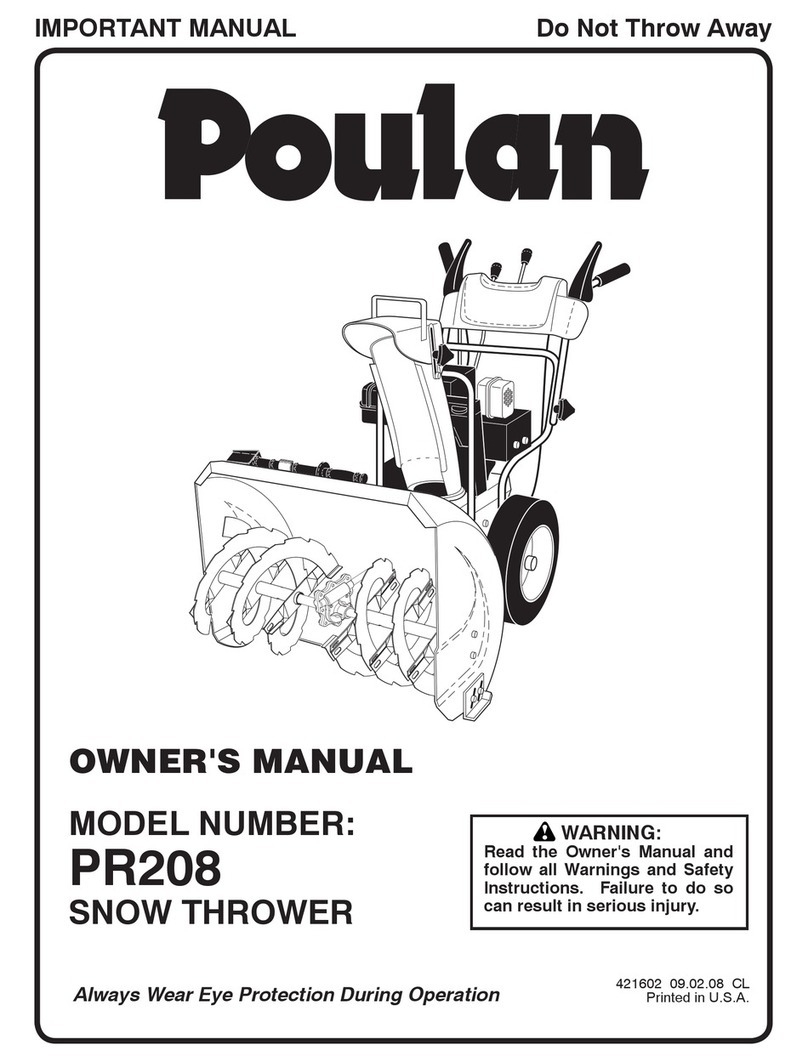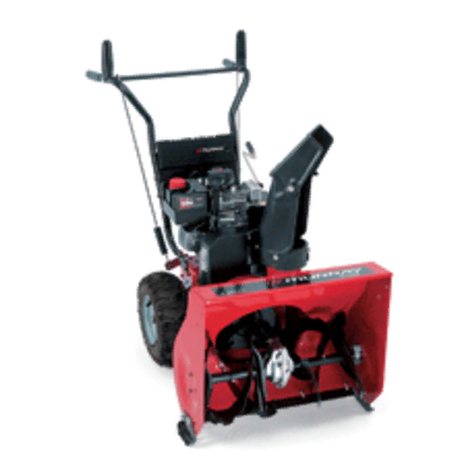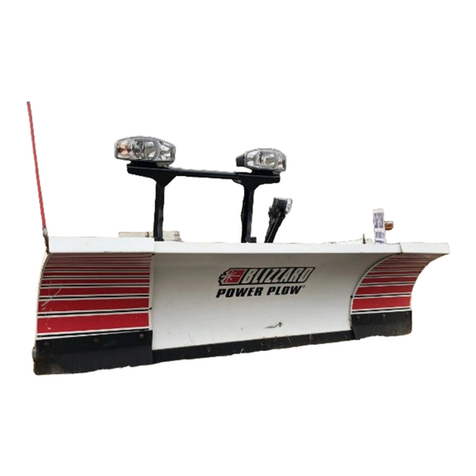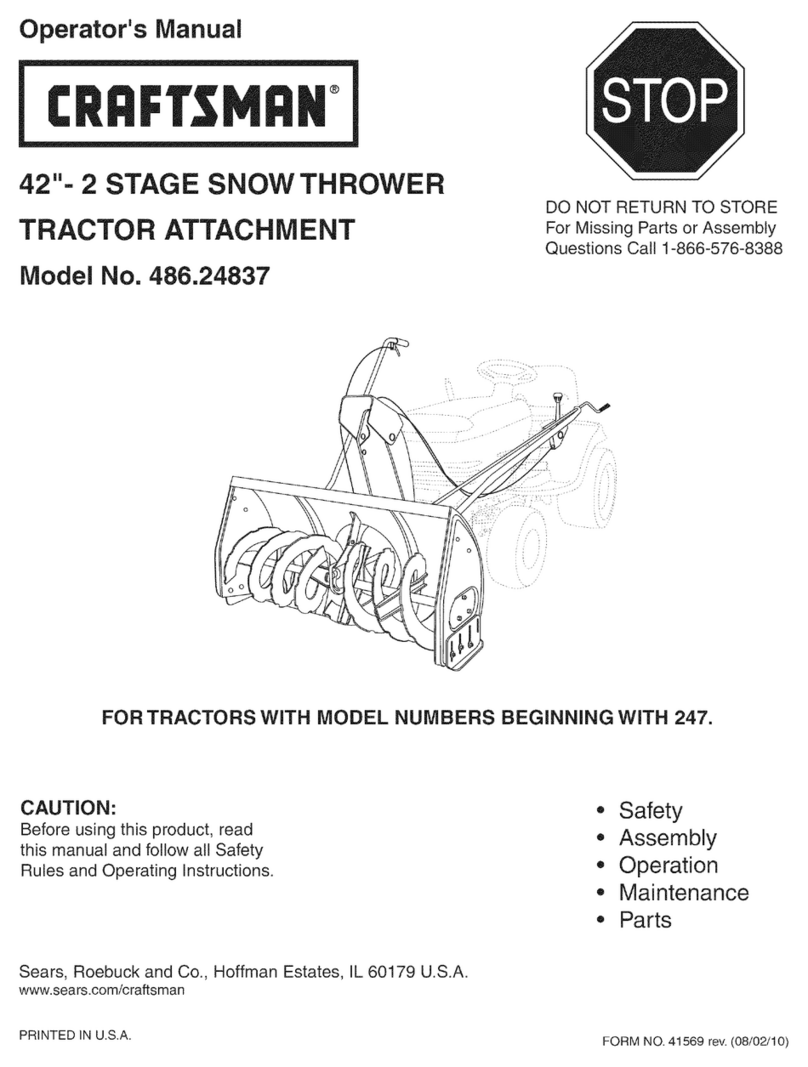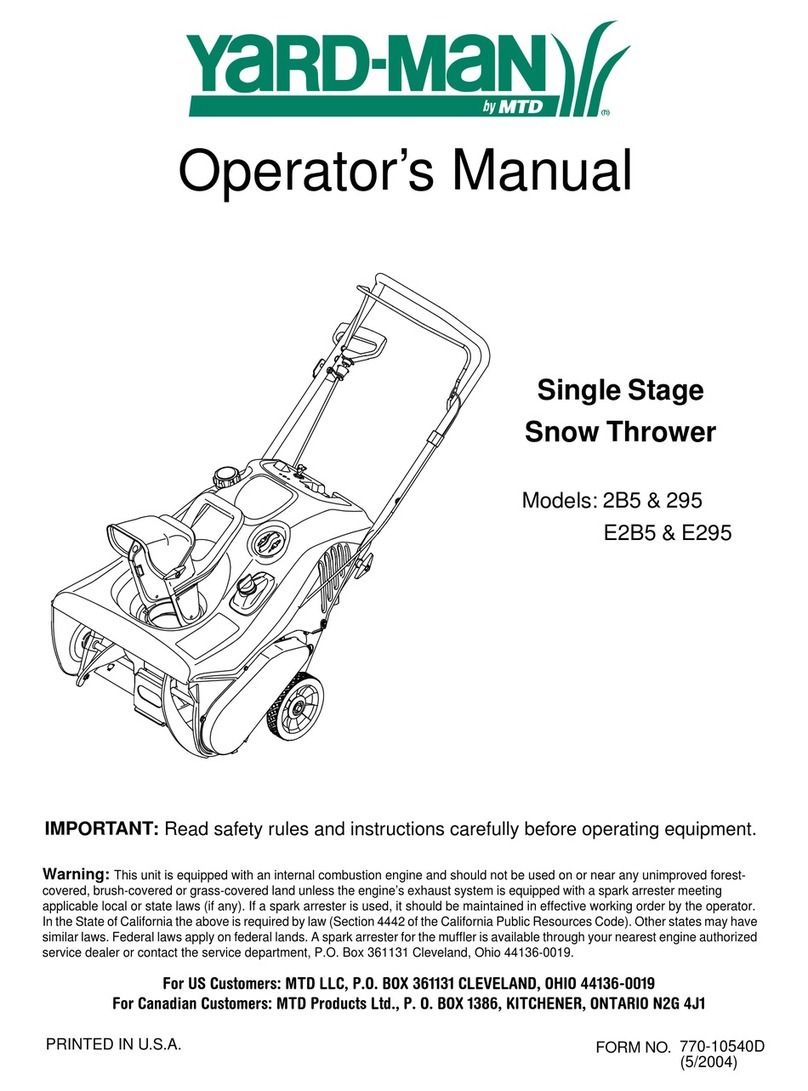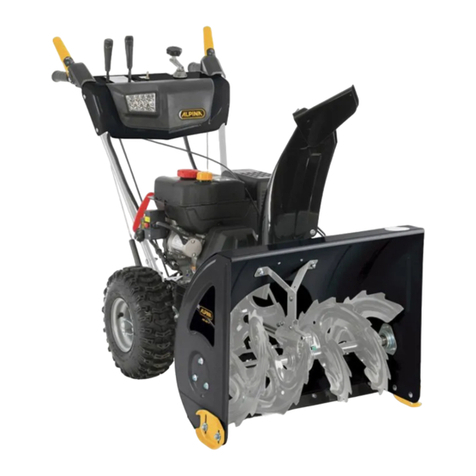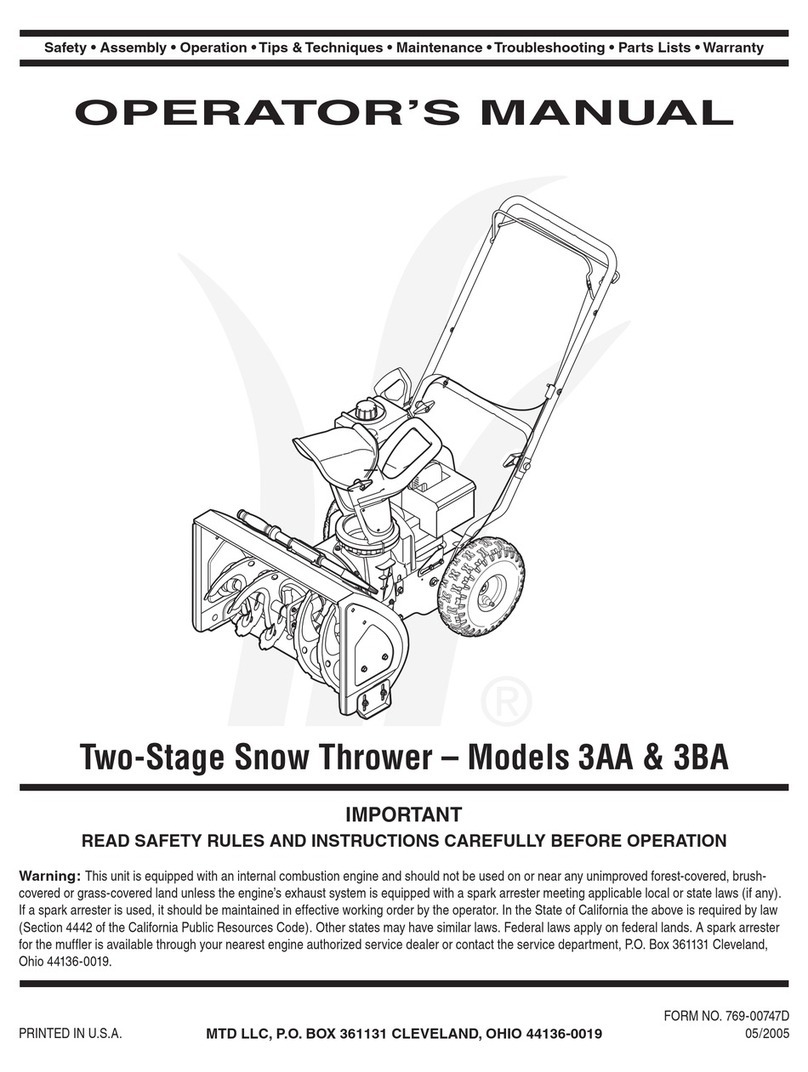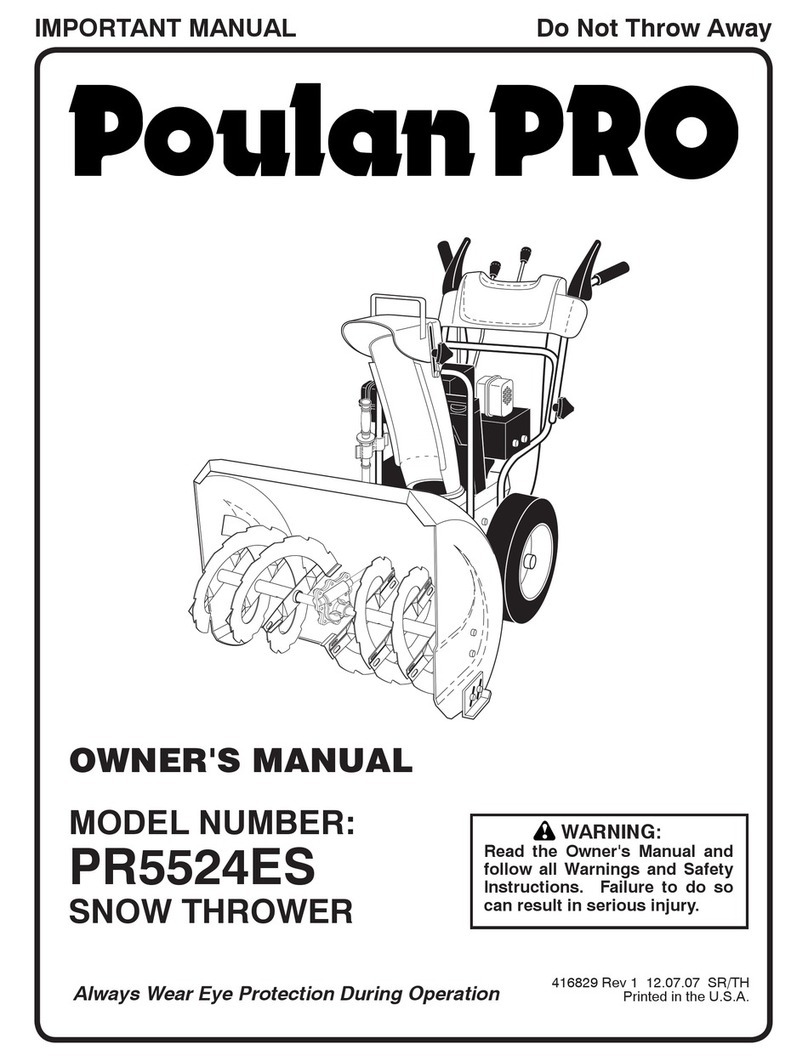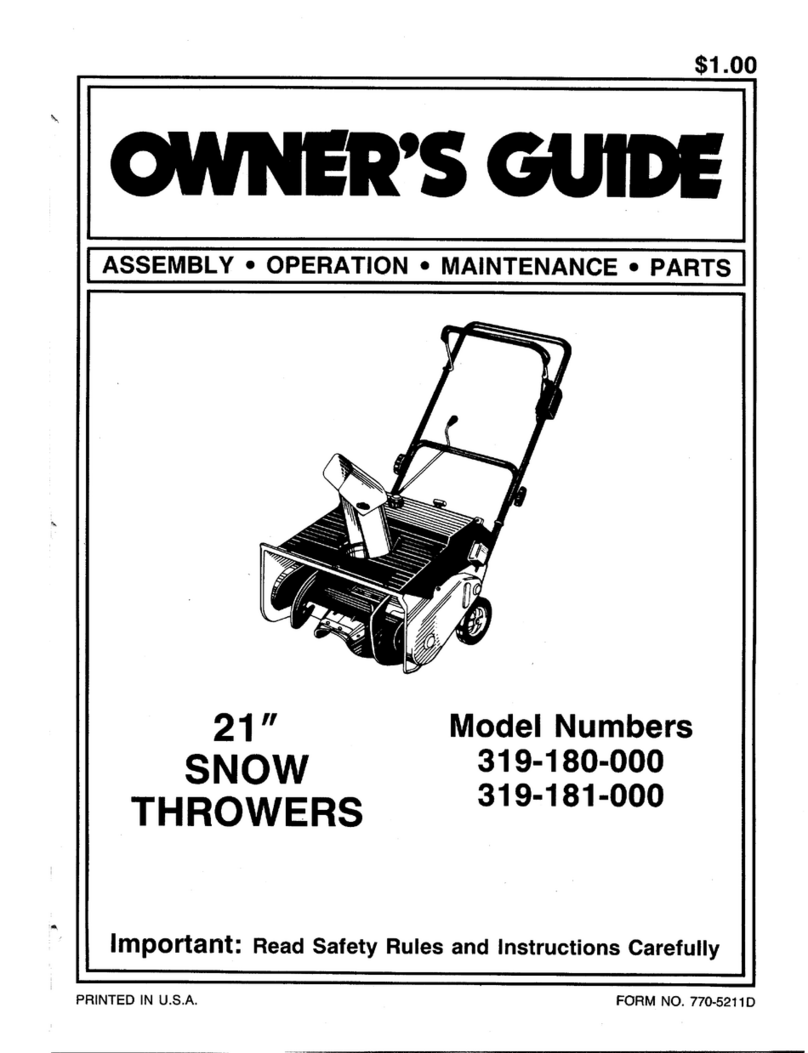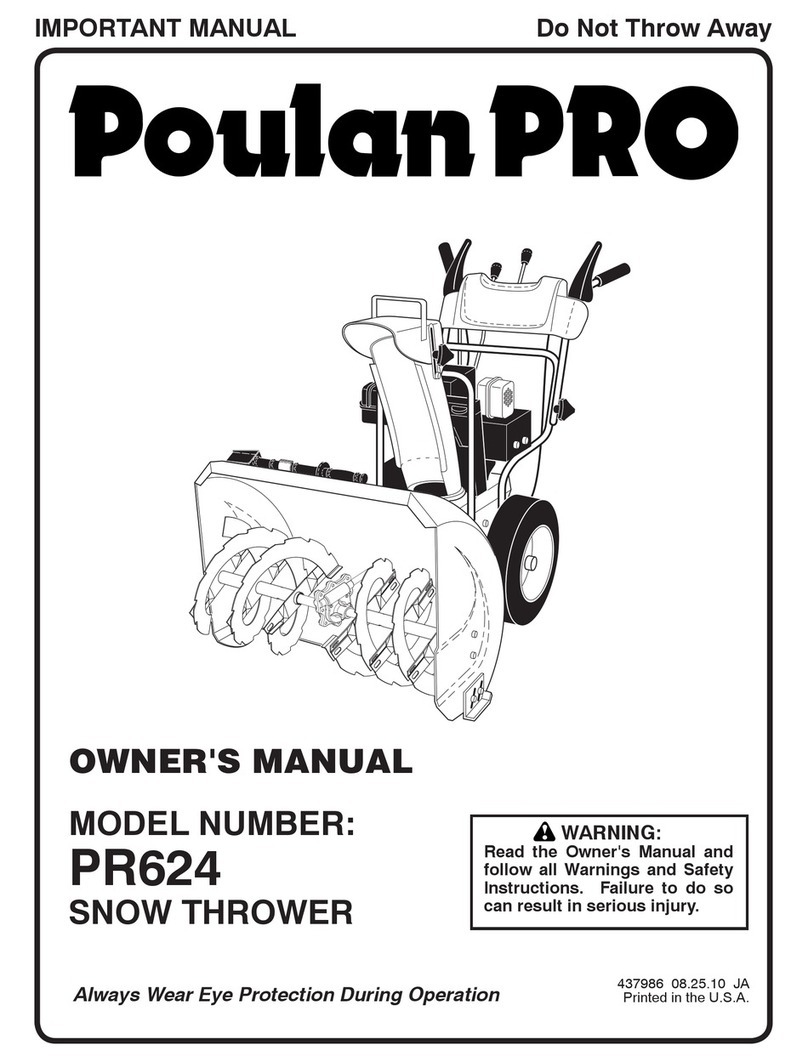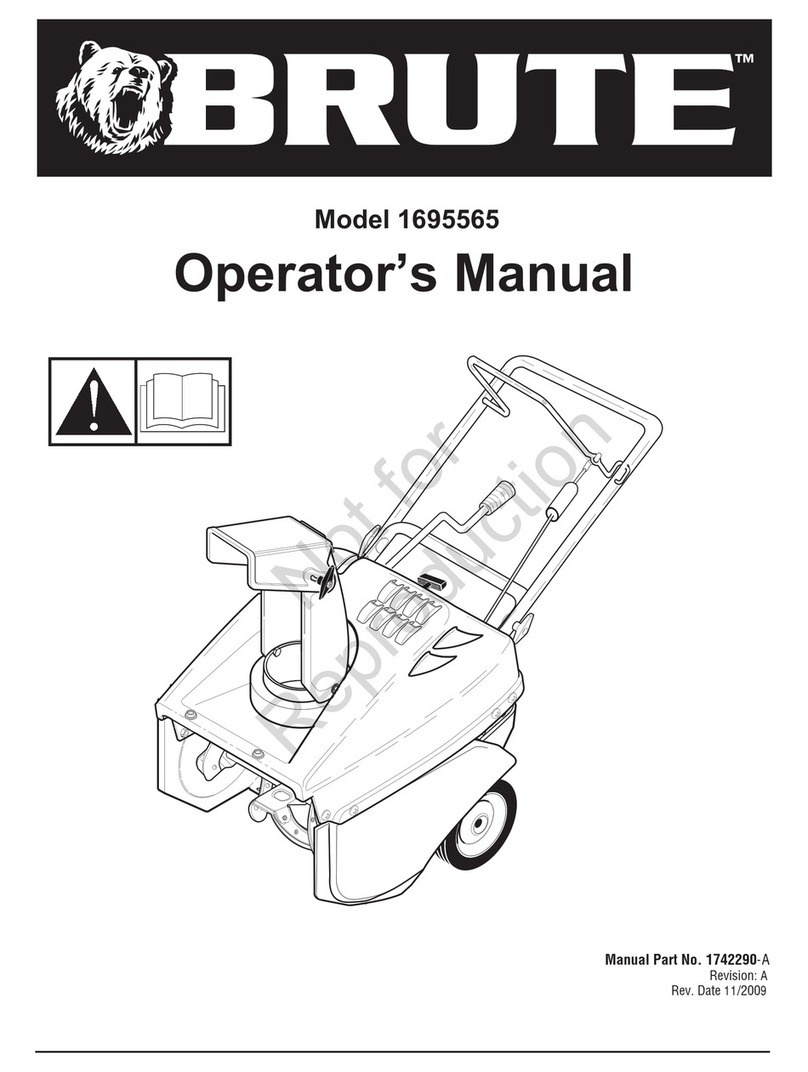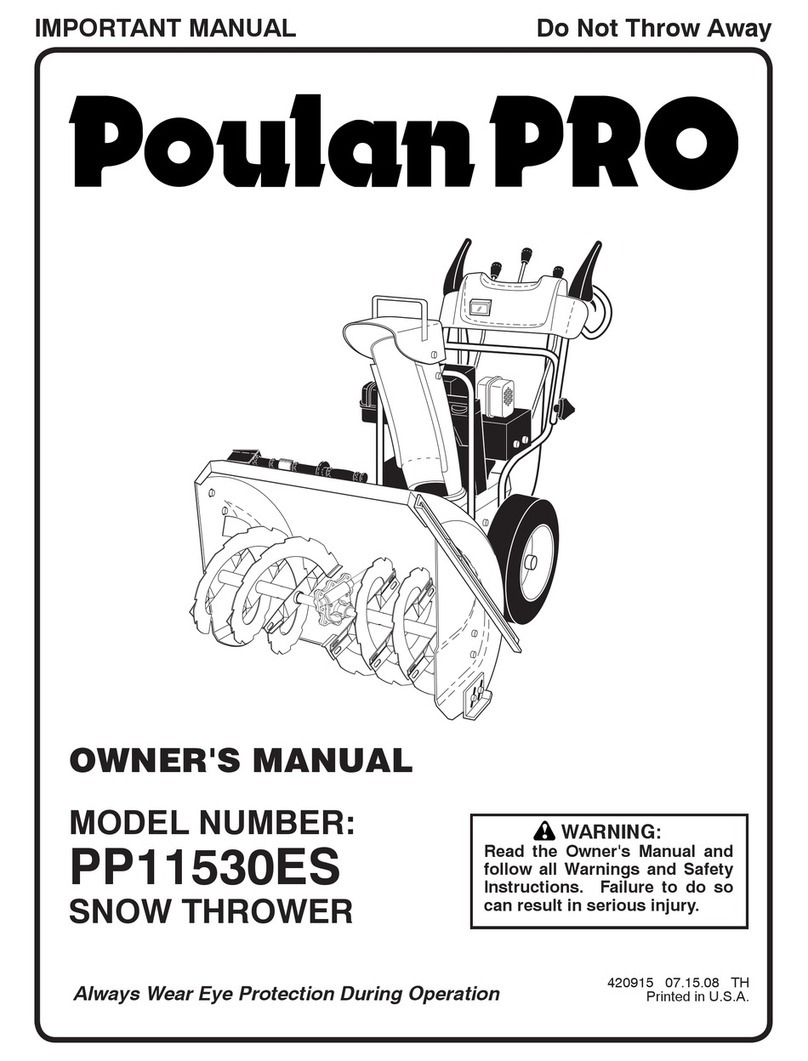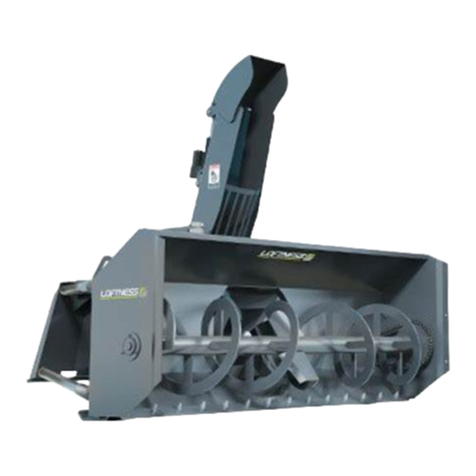FXA 60CM User manual

Instruction manual GB pg2-21
Käyttöohje FI pg21-40
Bruksanvisning SE pg41-60
Model Number: FXA 501976763
Mallinumero: FXA 501976763
Modellnummer: FXA 501976763

2
IMPORTANT: Read and understand this manual before assembling or operating this
Gasoline Snow thrower. Improper use of Snow thrower can cause severe injury. Keep this
manual for future reference.
TÄRKEÄÄ! Lue ja ymmärrä tämä käyttöohje ennen bensiinikäyttöisen lumilingon
kokoonpanoa tai käyttöä. Lumilingon väärä käyttö voi aiheuttaa vakavan
loukkaantumisen. Säilytä tämä ohje tulevaa tarvetta varten.
VIKTIGT: Läs och förstå denna bruksanvisning innan montering eller användning av
denna bensindrivna snöslunga. Felaktig användning av snöslungan kan orsaka allvarliga
personskador. Förvara dessa instruktioner för framtida referens.
Gasoloine snow thrower 60CM
Instruction manual
TABLE OF CONTENTS
I-Important Safe Operation Practices
II-Knowing Your Snow Thrower
III-Assembling and adjusting Your Snow Thrower
IV-Snow thrower preparation
V-Operating Your Snow Thrower
VI-Maintaining You Snow Thrower
VII-Storage&Cleaning Your Snow Thrower
VIII-Troubleshooting
IX-Explode drawing
X- EU Declaration of Conformity

I-
IMPORTANT SAFE OPERATION PRACTICES
This symbol points out important s
afe
and or property of yourself and other
s. R
operate this machine. Failure to c
omp
WARNING! This machine was built
to
with any type of power equipment,
ca
This machine is capable of amput
a
observe the following safety instruc
tions
Safety Symbol
This page depicts and describes safety symbols that may appear on this product. Read, understand and
follow all instructions on the
machine before attempting to assemble and operate.
Symbol Description
R
EAD THE OPERATOR
Read, understand and follow all instructions in the manual(s) before attempting to assemble and
operate.
The foll
owing warning symbols are to remind you of the safety precautions you should take when
operating the snow thrower.
Use ear protection
Use eye protection
Keep childen and pets a safe distance away from the machine.
WARNING-
ROTATING AUGER
Do not
put hands or feet near rotating parts, in the auger/impeller housing or chute assembly,
Contact with the rotating parts can
WARNING-
ROTATING BLADES
K
eep hands out of inlet and discharge openings while machine is running ,There
blades inside
WEARING-
THROWN OBJECTS
This machine may pick up and throw and objects which can cause serious personal injury
Do not touch any rotating part before machine stops.
WARNING-
ROTATING BLADES
K
eep hands out of inlet and d
blades inside
Waste electrical products should not be disposed of with household waste. Please recycle where
facilities exist. Check with your local authority or
3
IMPORTANT SAFE OPERATION PRACTICES
afe
ty instructions which, if not followed, could endanger the
s. R
ead and follow all instructions in this manual before a
tt
omp
ly with these instructions may result in personal injury.
to
be operated according to the safe operation practice
s in this m
ca
relessness or error on the part of the operator can re
sult in s
a
ting fingers, hands,toes and feet and throwing foreig
n obj
tions
could result in serious injury or death.
This page depicts and describes safety symbols that may appear on this product. Read, understand and
machine before attempting to assemble and operate.
EAD THE OPERATOR
’S MANUAL(S)
Read, understand and follow all instructions in the manual(s) before attempting to assemble and
owing warning symbols are to remind you of the safety precautions you should take when
operating the snow thrower.
Keep childen and pets a safe distance away from the machine.
ROTATING AUGER
put hands or feet near rotating parts, in the auger/impeller housing or chute assembly,
Contact with the rotating parts can
amputate hands and feet.
ROTATING BLADES
eep hands out of inlet and discharge openings while machine is running ,There
are rotating
THROWN OBJECTS
This machine may pick up and throw and objects which can cause serious personal injury
Do not touch any rotating part before machine stops.
ROTATING BLADES
eep hands out of inlet and d
ischarge openings while machine is running ,There are rotating
Waste electrical products should not be disposed of with household waste. Please recycle where
facilities exist. Check with your local authority or
retailer for recycling advice
personal safety
tt
empting to
s in this m
anual. As
sult in s
erious injury.
n obj
ects. Failure to
This page depicts and describes safety symbols that may appear on this product. Read, understand and
Read, understand and follow all instructions in the manual(s) before attempting to assemble and
owing warning symbols are to remind you of the safety precautions you should take when
put hands or feet near rotating parts, in the auger/impeller housing or chute assembly,
are rotating
This machine may pick up and throw and objects which can cause serious personal injury
ischarge openings while machine is running ,There are rotating
Waste electrical products should not be disposed of with household waste. Please recycle where

WARNING-
GASOLINE IS FLAMMABLE
Allow the engine to cool at least two minutes before refueling.
WARNING-
CARBON MONOXIDE
Never run an engine indoors or in a poorly ventilated area. Engine exhaust contains carbon
monoxide, an odorless and deadly gas.
WARNING-
ELECTRICAL SHOCK ( for engine with electric starter)
Do not use the engine
TRAINING
1,Read, understand , and follow all instructions on the machine and in the manual(s) before
attemptingto assemble and operate .Kee
reference and for ordering
replacement parts.
2.Be familiar with all controls and their proper operation . Know how to stop the machine and
disengage them quickly.
3,Never allow children under 18
years o
over should read and understand the operation instruction and safety rules in this manual and
should be trained and supervised by a parent.
4.Never allow adjust to operate this machine without proper in
5,Thrown
objects can cause serious personal injury. Plan your snow
discharge of material toward roads,bystanders and the like .
6,Keep bystanders, helpers, pets and children at least 75
operation. Stop machine if anyone enter the area
7, Exercise caution to avoid slipping or falling, especially when operating in reverse.
PREPARATION
Thoroughly inspect the area where
the
newspapers, sleds, boards, wires, b
ra
over or thrown by the auger/impeller.
•Always wear safety glasses or ey
e
adjustment or repair to protect y
our
serious injury to the eyes.
•Do not operate without wearing ad
e
scarves or other loose clothing, w
hi
footwear which will improve footi
ng
•Use a grounded three-wire exte
nsion
engines.
•Adjust housing height to clear gra
v
•Disengage all control levers befor
e
•Never attempt to make any a
djustm
specifically recommended in the
op
4
GASOLINE IS FLAMMABLE
Allow the engine to cool at least two minutes before refueling.
CARBON MONOXIDE
Never run an engine indoors or in a poorly ventilated area. Engine exhaust contains carbon
monoxide, an odorless and deadly gas.
ELECTRICAL SHOCK ( for engine with electric starter)
Do not use the engine
’s electric starter in the rain
1,Read, understand , and follow all instructions on the machine and in the manual(s) before
attemptingto assemble and operate .Kee
p this manual in a safe place for future and regular
replacement parts.
2.Be familiar with all controls and their proper operation . Know how to stop the machine and
years o
ld to operate this machine. Children 18
years old and
over should read and understand the operation instruction and safety rules in this manual and
should be trained and supervised by a parent.
4.Never allow adjust to operate this machine without proper in
struction.
objects can cause serious personal injury. Plan your snow
-
throwing pattern to avoid
discharge of material toward roads,bystanders and the like .
6,Keep bystanders, helpers, pets and children at least 75
feet from the machine while it is
operation. Stop machine if anyone enter the area
.
7, Exercise caution to avoid slipping or falling, especially when operating in reverse.
the
equipment is to be used. Remove all door
m
ra
nches and other foreign object, which c
ould be
e
shields during operation and while perfor
ming
our
eyes, thrown objects which ricochet can
ca
e
quate winter outer garments. Do not wear
j
hi
ch could become entangled in moving pa
r
ng
on slippery surfaces.
nsion
cord and receptacle for all machines w
ith
v
el or crushed rock surfaces.
e
starting the engine.
djustm
ents while engine is running, except wh
er
op
erator's manual.
Never run an engine indoors or in a poorly ventilated area. Engine exhaust contains carbon
1,Read, understand , and follow all instructions on the machine and in the manual(s) before
p this manual in a safe place for future and regular
2.Be familiar with all controls and their proper operation . Know how to stop the machine and
years old and
over should read and understand the operation instruction and safety rules in this manual and
throwing pattern to avoid
feet from the machine while it is
in
7, Exercise caution to avoid slipping or falling, especially when operating in reverse.
m
ats,
ould be
tripped
ming
an
ca
use
j
ewelry, long
r
ts, wear
ith
electric start
er
e

5
•Let engine and machine adjust to outdoor temperature before starting to clear snow.
PERSONAL SAFETY
•Engine exhaust, and certain vehicle components contain or emit chemicals known to
cause cancer, birth defects or other reproductive harm.
•Read, understand and follow all instructions on your Snow Thrower and in this Operator's
Manual before attempting to assemble and operate your machine.
•Keep this manual in a safe place for future and regular reference. If replacement parts
are needed, refer to the manual.
•Stay alert, watch what you are doing and use common sense when operating your Snow
Thrower.
•Do not use your Snow Thrower while you are tired or under the influence of drugs, alcohol,
medication. A moment of inattention while operating the Snow Thrower may result in
severe bodily injury.
•NEVER LEAVE YOUR RUNNING SNOW THROWER UNATTENDED. Stop the engine.
•Do leave your Snow Thrower until it has come to a complete stop.
•When stepping backwards, be cautious about any obstacles beneath your feet or behind
you avoid falling.
SERVICE
•Stop the engine before making any adjustments. Check for misalignment, breakage of or
binding of moving parts, and any other conditions that may affect operation.
•If damaged, have the Snow Thrower serviced by a qualified repair person using only
identical replacement parts. This will ensure that the safety of the Snow Thrower is
maintained.
SAFE HANDLING OF GASOLINE
•To avoid personal injury or property damage use extreme care in handling gasoline.
Gasoline is extremely flammable and the vapors are explosive. Serious personal injury can
occur when gasoline is spilled on yourself or your clothes which can ignite, wash your skin
and change clothes immediately.
•Use only an approved gasoline container.
•Extinguish all cigarettes, cigars, pipes and other sources of ignition.
•Never fuel machine indoors.
•Never remove gas cap or add fuel while the engine is hot or running.

6
•Allow engine to cool at least two minutes before refueling.
•Never over fill fuel tank.
•Replace gasoline cap and tighten securely.
•If gasoline is spilled, wipe it off the engine and equipment. Move machine to another area.
Wait 5 minutes before starting the engine.
•Never store the machine or fuel container inside where there is an open flame, spark or pilot
light (e.g. furnace, water heats, space heater, clothes dryer etc.).
•Allow machine to cool at least 5 minutes before storing.
•Never fill containers inside a vehicle or on a truck or trailer bed with a plastic liner.
Always place containers on the ground away from your vehicle before filling.
•If possible, remove gas-powered equipment from the truck or trailer and refuel it on the
ground.
•If this is not possible, then refuel such equipment on a trailer with a portable container,
rather than from a gasoline dispenser nozzle.
•Keep the nozzle in contact with the rim of the fuel tank or container opening at all times until
fueling is complete. Do not use a nozzle lock open device.
OPERATION
•Do not put hands or feet near rotating parts, in the auger impeller housing or chute
assembly. Contact with the rotating parts can amputate hands and feet.
•The auger impeller control lever is a safety device. Never bypass its operation. Doing so
makes the machine unsafe and may cause personal injury.
•The control levers must operate easily in both directions and automatically return to the
disengaged position when released.
•Never operate with a missing or damaged chute assembly. Keep all safety devices in
place and working.
•Never run an engine indoors or in a poorly ventilated area. Engine exhaust contains carbon
monoxide, an odorless and deadly gas.
•Do not operate machine while under the influence of alcohol or drugs.
•Muffler and engine become hot and can cause a bum. Do not touch. Keep children away.
•Exercise extreme caution when operating on or crossing gravel surfaces. Stay alert for
hidden hazards or traffic.

7
•Exercise caution when changing direction and while operating on slopes.
•Plan your snow-throwing pattern to avoid discharge towards windows, walls, cars etc. Thus,
avoiding possible property damage or personal injury caused by a ricochet.
•Never direct discharge at children, bystanders and pets or allow anyone in front of the
machine.
•Do not overload machine capacity by attempting to clear snow at too fast of a rate.
•Never operate this machine without good visibility or light. Always be sure of your footing
and keep a firm hold on the handles. Walk, never run.
•Disengage power to the auger impeller when transporting or not in use.
•Never operate machine at high transport speeds on slippery surfaces. Look down and
behind and use care when backing up.
•If the machine should start to vibrate abnormally, stop the engine, disconnect the spark plug
wire and ground it against the engine. Inspect thoroughly for damage. Repair any damage
before starting and operating.
•Disengage all control levers and stop engine before you leave the operating (behind the
handles).
•Wait until the auger /impeller comes to a complete stop before unclogging the chute
assembly, making any adjustments, or inspections.
•Never put your hand in the discharge or collector openings. Always use the clean-out tool
provided to unclog the discharge opening. Do not unclog chute assembly while engine is
running. Shut off engine and remain behind handles until all moving parts have stopped
before unclogging.
•Use only attachments and accessories approved by the manufacturer (e.g. wheel weights,
tire chains, cabs etc.).
•When staring engine, pull cord slowly until resistance is felt, then pull rapidly, Rapid
retraction of starter cord (kickback) will pull hand and arm toward engine faster then you can
let go. Broken bones, fractures, bruises or sprains could result.
•If situations occur which are not covered in this manual, use care and good judgment
contact customer support for assistance.
MAINTENANCE & STORAGE
•Never tamper with safety devices. Check their proper operation regularly. Refer to the
maintenance and adjustment sections of manual.
•Before cleaning, repairing, or inspecting machine disengage all control levers and stop the
engine.

8
•Wait until the auger impeller comes to a complete stop. Disconnect the spark plug wire to
prevent unintended starting.
•Check bolts and screws for proper tightness at frequent intervals to keep the machine in
safe working condition. Also, visually inspect machine for any damage.
•Do not change the engine governor setting or over speed the engine. The governor
controls the maximum safe operating speed of the engine.
•Snow thrower shave plates and skid shoes are subject to wear and damage. For your safety
protection, frequently check all components and replace with original equipment
manufacturers (OEM) parts only. Use of parts which do not meet the original equipment
specifications may lead to improper performance and compromise safety.
•Check control levels periodically to verify they engage and disengage properly and
adjust, if necessary. Refer to the adjustment section in this operator's manual for
instructions.
•Maintain or replace safety and instruction labels, as necessary.
•Observe proper disposal laws and regulations for gas, oil, etc. to protect the environment.
•Prior to storing, run machine a few minutes to clear snow from machine and prevent
freeze up of auger impeller.
•Never store the machine or fuel container inside where there is an open flame, spark or
pilot light such as water heater, furnace, clothes dryer etc.
•Always refer to the operator's manual for proper instructions on off-season storage.
•Check fuel line, tank, cap and fittings frequently for cracks or leaks. Replace if necessary.
•Do not crank engine with spark plug removed.
•Have the machine inspected annually by an authorized service dealer to ensure that all
mechanical and safety systems are working properly and do not worn excessively. Failure
to do so can result in accidents, injuries or death.
DO NOT MODIFY THE ENGINE
To avoid serious injury or death, do not modify engine in any way. Tampering with the governor
setting can lead to a runaway engine and cause it to operate at unsafe speeds. Never tamper
with factory setting of engine governor.

9
II-KNOWING YOUR SNOW THROWER
DB7004 Technical Specification
Gasoline Snowthrower
Displacement: 196 cm3
Power:3.8kW
Clearing Width: 600mm;
Clearing thickness: Approx.406mm;
Throwing distance: about 8m;
Throwing Operation: single stage;
Walking speed: 1 forward;
Discharge Chute: 180 Degree;
Chute Deflector: 70 degree;
Use the illustrations below to become familiar with the locations and functions of the various
components and controls of this snow thrower.
1 2 3 4
10 5
6
11
7
8
12
9
1 Fuel Tank Cap 8 Tire
2 Drive Control Handle 9 Skid Shoe
3 Chute Deflector Lever 10 Discharge Chute Deflector
4 Auger Control Handle 11 Discharge Chute
5 Chute Rotation Handle 12 Auger
6 Upper Handle
7 Lower Handle


11
Auger Control Handle
Located on the left side of the upper handle, the Auger Control Handle is used to engage and
disengage the augers. Squeeze the Auger Control Handle to engage the augers; release to
disengage the augers.
Chute Rotation Handle
To adjust snow discharge direction, rotate the handle clockwise or counter-clockwise.
Skid Shoe
Position the shoes based on the surface conditions. Adjust upward for hard-packed snow.
Adjust downward when operating on gravel or crushed rock surfaces.
Auger
When engaged, the augers rotate to cut snow and be discharged out the chute.
Discharge Chute
The chute provides a discharge path for snow being thrown. The chute is adjustable.
III-Assembling and adjusting Your Snow Thrower
Unpacking
Unpack the snow thrower and all its parts, and compare against the list below.
1. Snow Thrower
2. Upper Handle with Discharge Chute Assembly
3. Crank Handle
4. One Pair of Skid Shoes with hardware
ASSEMBLY
Your Snow Thrower will require some assembly. Please complete the following steps before
using your Snow Thrower.
WARNING: This snow thrower is heavy. Assembly procedures may require lifting
equipment or two people.

12
Step 1 – Upper handle assembly
1.Attached the upper handle to the lower handle using (4) knobs,
washers and bolts.
Knob,Washer and Bolt
Step 2 – Chute assembly
1.Install the discharge chute onto the chute flange on
the auger housing. The chute only rests on the
flange.
2
1
2.Using provided 2 bolts and nuts (1) to lock chute direction support column (2) in position.

13
3.Slide the crank handle through the mounting hole
on upper handle.
Mounting Hole
4.Attach the crank handle to the mount bracket onto
the chute housing using spring locking pin.
Spring Locking Pin
Step 3 – Skid shoes installation and adjustments
1. Locate the pair of skid shoes from parts bag and remove the bolts.
2. Loosely install the skid shoes using the bolts and hex nuts
as shown on each side of the auger housing. Make sure
the skid shoe tip faces out.
Adjustment of the skid shoes sets the height above the ground
at which the auger shave plate operates.
For clearing snow from concrete, asphalt, and other smooth surfaces, set the auger shave
plate so that the bottom of the plate is just above the ground.
For clearing snow from gravel, dirt, and other rough surfaces set the auger shave plate slightly
above the ground to avoid dirt and gravel from entering the auger.
The optimal height of the plate will vary depending on the type of surface being cleared.
Surfaces with larger gravel or stones require a higher shave plate setting.
3. Move the Snow Thrower to a solid, smooth, and level surface.
4. Place a spacer board on the ground underneath the auger shave plate between the skid
shoes. The thickness of the board should be the same as the height above the ground you
wish to raise the auger shave plate. The skid shoes should not touch the board.
5. With the two (2) nuts loose allow the skid shoe to slide to the ground then tighten the nuts
to secure the skid shoe.

IV-Snow ThrowerPreparation
ADD OIL
The snow thrower is shipped without oil. User must add the proper amount of oil before
operating the snow blower for the first time. The oil capacity of the engine crankcase is 0.6 L.
For general use, we recommend 5W, 4-stroke engine oil.
ENGINE OIL RECOMMENDATIONS
Select good quality detergent oil bearing the American Petroleum Institute (API) service
classifications SJ, SL, or SM (synthetic oils may be used). Use the ASE viscosity grade of oil
from the following chart that matches the starting temperature anticipated before the next oil
changes.
To add oil, follow these steps:
1. Make sure the snow thrower is on a level surface. Tilting the
snow thrower to assist in filling will cause oil to flow into
engine areas and will cause damage. Keep snow thrower
level!
2. Remove the dipstick from the engine.
3. Add oil slowly as to not overflow the unit.
4. To check the oil level, wipe the dipstick with a clean rag.
Insert the dipstick into the oil fill opening without screwing it
in. Remove the dipstick to check the oil mark.
5. Slowly add more oil and repeat step 4 until the oil mark
reaches to the top of the dipstick. Do not overfill the
crankcase.
6. Check for oil leaks. Tighten dipstick firmly.
ADD GASOLINE
Use fresh (within 30 days from purchase), lead-free gasoline with a minimum of 87 octane
rating. Do not mix oil with gasoline.
To add gasoline, follow these steps:
1. Make sure the snow thrower is on a level surface.
2. Unscrew fuel tank cap and set aside. NOTE: The fuel cap may be tight and hard to unscrew.
3. Slowly add unleaded gasoline to the fuel tank. Be careful not to overfill. The capacityof the
fuel tank is 2.6L. NOTE: Do not fill the fuel tank to the very top. Gasoline will expand and
spill over during use even with the fuel cap in place.
4. Reinstall fuel cap and wipe clean any spilled gasoline with a dry cloth.
IMPORTANT:
•Never use an oil/gasoline mixture.
•Never use old gasoline.
•Avoid getting dirt or water into the fuel tank.
•Gasoline can age in the tank and make starting difficult. Never store snow thrower for
extended periods of time with fuel in the tank or the carburetor.
•NOTE: After completing the above preparation, the engine is ready to be started.

15
WARNING! Keep the area of operation free from foreign objects that can be thrown by the
auger and/or impeller blades. Perform a thorough inspection of the area since some objects
may be hidden from view by surrounding snow. If the Snow Thrower hits an obstruction or
picks up a foreign object during use, stop the Snow Thrower, remove the obstruction, and
inspect it for damage. Repair or replace any damaged parts before restarting and operating you
Snow Thrower.
•Keep children, pets, and bystanders away from the area of operation. Be aware that the
normal noise of the Snow Thrower when turned on may make it difficult for you to hear
approaching people.
•Start your clearing path by throwing snow in a back and forth motion. To clear in the
opposite direction, stop your Snow Thrower and pivot it on its wheels to face the opposite
direction. Make sure to overlap clearing paths.
•Determine the direction of the wind. If possible, move in the same direction as the wind
so that the snow is not thrown against the wind, back into your face and on the just
cleared path.
WARNING! DO NOT USE YOUR HANDS TO UNCLOG CHUTE. Stop the motor before
removing debris. Use thesupplied clean out tool to unclog the chute. Do not walk in front of your
running Snow Thrower. Do not direct discharged snow towards bystanders.
•Do not apply additional man-made load to the engine since this may damage the engine.
•Some parts of your Snow Thrower may freeze under extreme temperature conditions. Do
not attempt to operate your Snow Thrower with frozen parts. If the parts freeze while your
Snow Thrower is in use, stop your Snow Thrower and inspect it for frozen parts. Thaw all
parts before restarting and operating your Snow Thrower. Never force parts or controls
that have frozen. Never use an open flame of any sort to thaw frozen parts.
Pre-Operation Inspection - IMPORTANT!!!
Before using your Snow Thrower for the first time, check the following:
•Have you read and followed all setup and operation procedures for the engine as
outlined in the ENGINE manual?
•Has the engine been filled with oil and gasoline to the proper level?
•Are all snow thrower components properly attached and assembled?
•Are there any broken or damaged parts?
•Are all fasteners tight?
•Are the tires inflated to the proper pressure?
AUGER AND DRIVE CONTROLS
1. To engage the auger, press down on the auger control handle
(left side handle).
2. To engage the drive, press down on the drive control handle (right side handle). The
machine should start moving in the direction and speed that the speed control lever
is set to.
3. When finished clearing a snow path, release the auger control handle and the
drive control handle.
Attention: Release (disengage) the auger and drive control handles before
adjusting the drive speed control lever. Never change the drive speed while your
snow thrower is moving, it could damage the drive mechanism and void the warranty.

16
V-Operating Your Snow Thrower
MANUAL START THE ENGINE
To manual start the engine,perform the following steps
1. Move the fuel valve lever to the ON position.
2.To start a cold engine, move the choke lever to the CLOSE position.
To restart a warm engine, leave the choke lever in the OPEN position.
3.Turn the engine switch to the ON position.
4.Pull the starter grip lightly until you feel resistance, then pull briskly. Return the starter grip gently
5. If the choke lever has been moved to the CLOSE position to start the engine, gradually move it to
the OPEN position as the engine warms up.
CLEARING SNOW
Start the engine once your Snow Thrower has been running outside for several
minutes, it is now ready for use. Make sure the path in front of your Snow Thrower is free
from people, animals, objects, and all other obstructions except for snow.
Adjust the chute outlet to the desired direction.
Turn the chute rotation handle clockwise or counter-clockwise until the desired position is reached.
WARNING! Never direct the chute outlet toward people or animals. While snow may seem
harmless, it can contain rocks or other debris that can cause serious injury when projected
through the chute.
1.Engage/depress the auger control handle to start the augers and impeller turning.
2.Set the desired direction and speed using the speed control lever.
3.Engage/depress the drive control handle and direct the snow thrower into the snow to be cleared.
NOTICE: Do not change speed positions while the drive is engaged. Disengage the drive control
handle BEFORE changing speeds or directions. If the snow is deeper than the height of the auger,
remove it in several steps taking narrower swaths. Make several passes with the auger
overlapping the cleared areas and reduce forward speed.
For the best clearing efficiency, clear snow before it melts, refreezes and hardens. Hard packed
and wet snow can be very difficult to clear.
Clearing wet heavy snow can be a challenge, depending on ambient temperature, humidity levels,
and overall climate conditions including actual snow conditions, there may be no 100% solution as
snow may be too wet or compacted to move or throw. Wet snow will tend to clog and stick more to
the augers and chute. Keep the auger engaged as much as possible when clearing wet snow to
help prevent clogging.
WARNING! If snow is filled with foreign material, damage to the snow thrower may result. Avoid
snow with foreign materials.

17
STOPPING
When finished using your Snow Thrower, perform the following steps to shut it down.
1. Engage the auger and impeller for 30 seconds to clear any remaining snow inside
your Snow Thrower.
2. Stop the auger by releasing the left control handle.
3. Set the engine switch to the OFF position. See ENGINE manual for stopping procedures.
4. Remove snow from all Snow Thrower surfaces including the auger housing and chute areas.
VI-Maintaining Your Snow Thrower
WARNING! Never perform maintenance while your Snow Thrower is running. Turn OFF the
engine before performing any maintenance tasks on your Snow Thrower.
Proper maintenance of your Snow Thrower will help prolong its life. Please perform the
following maintenance procedures as required.
Do not attempt to repair your Snow Thrower unless you have the proper tools and
instructions for disassembly and repair.
Check the bolts at frequent intervals for proper tightness to ensure that the equipment is in
safe working condition.
After each snow removal session, run the Snow Thrower for a few minutes to prevent the
collector
/impeller from freezing. Stopthe engine, wait for all revolving parts tostop completely, and wipe
residual ice and snow off the unit. Rotate the chute rotation handle several times to remove
any excess snow.
MAINTENANCE PROCEDURES
TIRE INFLATION
Before each use of your Snow Thrower, check the tire pressure. The pressure in each tire should
be in the
range of 20-24 psi for the best performance. The pressure can be checked using an ordinary tire
pressure gauge. Fill the tires using a small or pressure regulated air compressor.
WARNING! DO NOT OVER-INFLATE THE TIRES. Over-inflating could cause a tire to burst
and cause severe bodily injury.
SHAVE PLATE REPLACEMENT
Remove both skid shoes and hardware including carriage bolts and nuts which attach shave
plate to snow thrower housing. Reassemble new shave plate, making sure heads of the carriage
bolts are to the inside of the auger housing.

18
VII-Storage & Cleaning Your Snow Thrower
PROPER STORAGE PROCEDURES
WARNING! Never store your Snow Thrower for extended periods of time with fuel in the tank
or carburetor. Fuel stabilizer can be added to the fuel in can to extend its shelf life for storage.
Store the unit in a locked, dry place out of the reach of children to prevent unauthorized use or
damage. Cover loosely with a tarp for added protection.
CLEANING
1. To clean your Snow Thrower, use a damp cloth and mild detergent on the surfaces only.
Never get soap or water inside the working mechanisms of your Snow Thrower.
Note: Do not clean with water. Water will freeze due to low temperature and damage the
machine.
2. Clean the Snow Thrower of snow and ice buildup before storing or transporting. Be sure to
secure the unit while transporting.
3. Inspect the Snow Thrower carefully for worn, loose, or damaged parts. Check
connections and screws and tighten if necessary.

19
VIII-Troubleshooting
Pr
obl
e
m
C
aus
es
R
e
m
e
dy
W
ARN
I
N
G
- Before attempting to make any inspections, repairs or adjustments, stop the engine, wait
for all moving parts to stop moving and carefully disconnect the engine spark plug wire. If tipping or turning
the snow blower is required for any inspection or repair, first wait until the engine is cool to the touch and
then drain the engine of all fuel and oil into suitable containers and store or dispose of in a proper manner.
Engine
Sys
te
m
s
- Note: For all engine problems, see the Engine Operator's manual for additional
troubleshooting information and engine manufacturer contact information.
Engine Fails to Start
(Engine cranks over) Engine ignition switch in
OFF position Position engine ignition switch to ON
Spark plug wire
disconnected Connect wire to spark plug
Faulty spark plug Clean, adjust gap, or replace spark plug , see Engine
Operator's manual
Engine flooded with fuel Discontinue choke or primer use, clean or replace
spark plug.
Choke not in START
position Move choke to START position, after engine starts
slowly move to RUN position as engine speed and
operation stabilizes at the set rpm. If engine still does
not start move to half choke and crank engine.
Engine not primed with
fuel Prime engine, see Engine Operator's manual
Fuel incorrect, old or stale,
will not ignite Empty and clean fuel tank & carburetor, refill with
fresh, clean gasoline. (Note: Fuel may become stale
after 30 days in some cases)
Blocked or clogged fuel
system or line Clean fuel system or line
Fuel shut-off valve in OFF
position Turn fuel shut-off valve to ON position
CHOKE in ON or partial
ON position Move CHOKE lever to RUN
Engine runs erratic,
stalls or seems low
on power
Fuel incorrect, old or stale Empty and clean fuel tank & carburetor, refill with
fresh, clean gasoline. (Note: Fuel may become stale
after 30 days in some cases)
Blocked or clogged fuel
system or line Clean fuel system or line
Carburetor is in need of
cleaning Clean fuel system and carburetor
Spark plug wire loose Connect and tighten spark plug wire
Faulty spark plug Clean, adjust gap, or replace spark plug , see Engine
Operator's manual
Engine oil over filled Drain oil to proper level. Oil should not be above
the top 2 threads of LOWER fill plug.
Engine oil level low or
empty Add oil

IX- Explode drawing
This manual suits for next models
1
Table of contents
Languages:
Other FXA Snow Blower manuals
